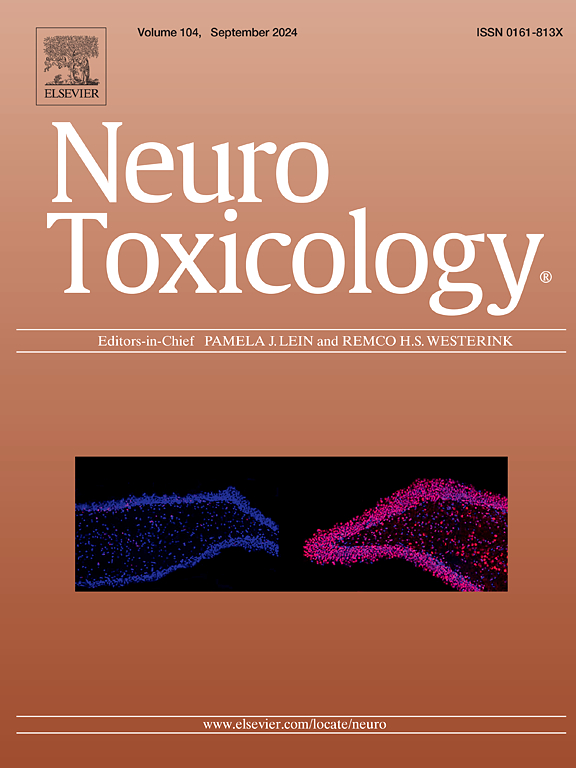TREM2-mediated neuroinflammatory response is involved in AgNPs-induced ferroptosis in HMC3 cells
IF 3.9
3区 医学
Q2 NEUROSCIENCES
引用次数: 0
Abstract
Silver nanoparticles (AgNPs) are widely used in industrial and biomedical applications owing to their superior physicochemical properties, especially antimicrobial activity. However, their potential health risks raise concerns. Given that the central nervous system (CNS) is a major target of AgNPs, assessing their neurotoxic effects is critical for safety evaluation. Recent studies suggest that ferroptosis may play a pivotal role in AgNPs-induced neurotoxicity, yet the underlying molecular mechanisms remain unclear. This study is the first to investigate AgNPs-triggered ferroptosis in human microglial cells (HMC3) and explore the regulatory role of triggering receptor expressed on myeloid cells 2 (TREM2)-mediated inflammatory responses. Following exposure to AgNPs (0, 50, 100, and 200 μg/mL) for 48 h, HMC3 cells exhibited dose-dependent cytotoxicity. Further analyses revealed mitochondrial ultrastructural and functional damage, intracellular Fe²⁺ overload, elevated ROS levels, GSH depletion, and increased lipid peroxidation, accompanied by dysregulated expression of ferroptosis-related proteins. Inflammatory profiling demonstrated reduced TREM2 protein levels, elevated pro-inflammatory markers, and decreased anti-inflammatory markers, indicating AgNPs-induced inflammatory responses. Treatment with the TREM2 agonist COG 1410 (5 μg/mL) significantly upregulated TREM2 expression, attenuated pro-inflammatory factors, and enhanced anti-inflammatory factors. Moreover, TREM2 activation significantly inhibited AgNPs-induced ferroptosis in HMC3 cells, indicating that TREM2-mediated inflammation may play a key role in regulating this process. These findings offer new understanding of AgNPs neurotoxicity and potential therapeutic targets for reducing CNS damage from AgNPs exposure.
trem2介导的神经炎症反应参与了agnps诱导的HMC3细胞铁下垂。
银纳米粒子(AgNPs)由于其优越的物理化学性质,特别是抗菌活性,在工业和生物医学应用中得到了广泛的应用。然而,它们潜在的健康风险令人担忧。鉴于中枢神经系统(CNS)是AgNPs的主要靶点,评估其神经毒性作用对安全性评估至关重要。最近的研究表明,铁下垂可能在agnps诱导的神经毒性中起关键作用,但其潜在的分子机制尚不清楚。本研究首次研究了agnps在人小胶质细胞(HMC3)中引发的铁凋亡,并探索了触发受体表达对髓样细胞2 (TREM2)介导的炎症反应的调节作用。暴露于AgNPs(0、50、100和200μg/mL) 48小时后,HMC3细胞表现出剂量依赖性的细胞毒性。进一步的分析显示,线粒体超微结构和功能损伤、细胞内Fe 2 +过载、ROS水平升高、GSH耗竭、脂质过氧化增加,并伴有铁中毒相关蛋白的表达失调。炎症谱显示TREM2蛋白水平降低,促炎标志物升高,抗炎标志物降低,表明agnps诱导的炎症反应。TREM2激动剂COG 1410 (5μg/mL)可显著上调TREM2表达,减弱促炎因子,增强抗炎因子。此外,TREM2激活显著抑制agnps诱导的HMC3细胞铁凋亡,表明TREM2介导的炎症可能在调节这一过程中发挥关键作用。这些发现提供了对AgNPs神经毒性的新认识和减少AgNPs暴露对中枢神经系统损伤的潜在治疗靶点。
本文章由计算机程序翻译,如有差异,请以英文原文为准。
求助全文
约1分钟内获得全文
求助全文
来源期刊

Neurotoxicology
医学-毒理学
CiteScore
6.80
自引率
5.90%
发文量
161
审稿时长
70 days
期刊介绍:
NeuroToxicology specializes in publishing the best peer-reviewed original research papers dealing with the effects of toxic substances on the nervous system of humans and experimental animals of all ages. The Journal emphasizes papers dealing with the neurotoxic effects of environmentally significant chemical hazards, manufactured drugs and naturally occurring compounds.
 求助内容:
求助内容: 应助结果提醒方式:
应助结果提醒方式:


